Aquaguard for Bathing and Showering with a Central Line
These instructions are for Children's Hospital of Philadelphia (CHOP) patients who are recommended to use AquaGuard® for bathing or showering.
Important information about AquaGuard:
-
AquaGuard is a moisture barrier that is used to protect a central line catheter and dressing from getting wet during a shower or bath. It is important to keep the catheter and dressing dry to prevent urgent central line care and potential complications.
-
AquaGuard is a barrier for bathing and showering only and is not for swimming. A child with a central line cannot go swimming or have their central line submerged under water.
-
If you will use an AquaGuard at home, the healthcare team will show you how to use this product. Practice applying this product before discharge, so you know what to do for a bath or shower at home.
Instructions for applying AquaGuard for bath or shower:
Apply the AquaGuard so that it covers your child's central line dressing and catheter before they take a shower or bath. The AquaGuard adhesive should not touch your child's central line dressing.
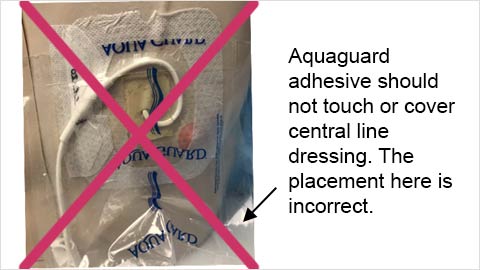
-
Remove the paper backing from one edge of the AquaGuard at a time. It is helpful to fold a small tab on each paper backing strip so that the backing can be easily removed while applying each side.
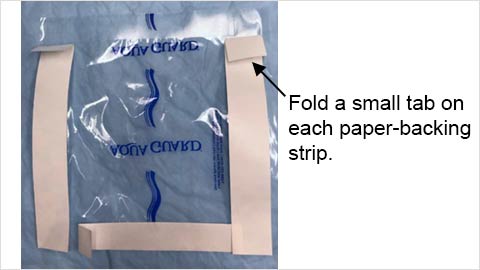
-
Firmly apply one adhesive edge above the top of the central line dressing.
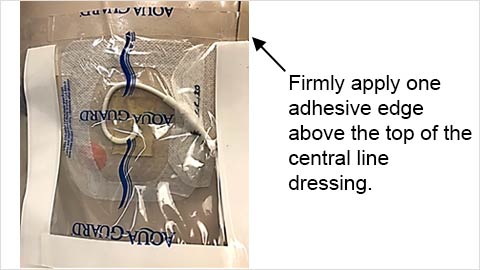
-
Apply the other adhesive edges to surround the entire catheter and dressing like a picture frame. Firmly apply one side at a time. Do not remove all paper backing strips at once.
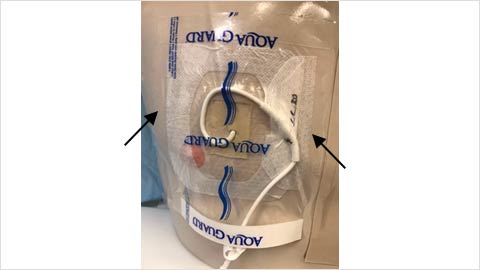
-
Tuck the catheter under the AquaGuard so that the catheter cannot get wet. You may choose to cover the needleless cap with a small AquaGuard or plastic covering prior to tucking under the larger AquaGuard. This may offer additional protection from moisture for the needleless cap. Important: If you are a Dialysis or Apheresis patient, do not tuck the catheter under the AquaGuard.
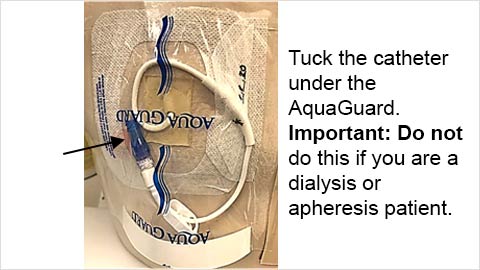
-
Pinch together excess material to form a pleat.
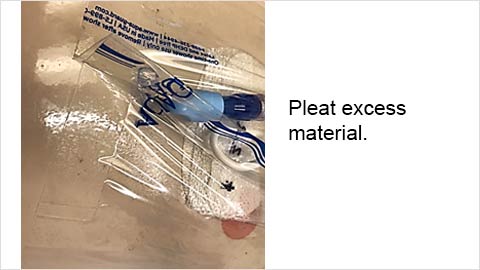
-
Fold the pleat to the side to seal the material. Run your finger along each side of the AquaGuard adhesive as a final sealing step.
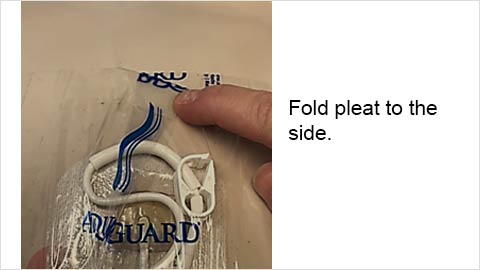
-
The AquaGuard only protects the dressing and catheter from splashing water. Do not allow direct water spray to hit the AquaGuard. Do not submerge the AquaGuard.
-
Limit the shower or bath to 15 minutes to make sure the AquaGuard adhesive remains intact.
-
Face the central line dressing away from any direct water spray. Use or install a handheld showerhead. If bathing, fill the tub with only a few inches of water to prevent splashing. For infants, a baby bath is helpful.
Instructions for removing AquaGuard:
-
Dry your child and the outside of the AquaGuard before removing the AquaGuard.
-
Gently peel the AquaGuard down in the same direction as your child's hair growth.
-
Start at the top left or top right corner. Do not disturb the central line dressing or catheter.

-
Do not use scissors to remove the AquaGuard.
-
Throw the AquaGuard away after the shower or bath.
Instructions for troubleshooting issues with AquaGuard:
AquaGuard is sticking to the central line dressing or the dressing begins to peel up while removing the AquaGuard:
Central line dressing or needleless cap gets wet or water gets under the AquaGuard:
Your child's skin is red, irritated or there is an issue with using AquaGuard:
You did not receive enough supply of AquaGuard or a different product was delivered:
Call the CHOP team managing your child's central line with any questions or concerns.
Reviewed on June 1, 2022, by Catherine Murtaugh, RN; Jean Abraitis, RN